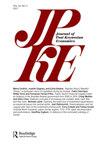外围经济体经验股票流动一致模型中的内生汇率:以阿根廷为例
IF 1
3区 经济学
Q4 ECONOMICS
引用次数: 1
摘要
摘要近年来,应用于特定国家的经验SFC模型越来越多,以解决广泛的研究问题。然而,在大多数情况下,汇率被建模为外生汇率。这妨碍了分析全球金融周期影响经济的多种渠道,以及国内经济政策的不同工具对外部部门和宏观金融稳定的影响。为了克服这一限制,本文提出了一个阿根廷的季度SFC实证模型,其中汇率是在Godley和Lavoie提出的线之间建模的。该模型包括多种经济政策工具,这些工具在最近影响了汇率稳定,从而影响了整个经济。结果表明,该模型中使用的闭包有助于为其他外围国家构建类似的模型,在这些国家,名义汇率是由国内经济和世界其他地区不同过程的相互作用产生的。本文章由计算机程序翻译,如有差异,请以英文原文为准。
Endogenous exchange rates in empirical stock-flow consistent models for peripheral economies: an illustration from the case of Argentina
Abstract In recent years there has been an increase in empirical SFC models applied to specific countries to address a broad range of research questions. However, in most cases, the exchange rate has been modeled as exogenous. This prevents the analysis of both the multiplicity of channels through which the global financial cycle impacts economies and the effects that the different tools of domestic economic policy have on the external sector and macro-financial stability. To overcome this limitation, this paper presents an empirical quarterly SFC model for Argentina where the exchange rate is modeled among the lines proposed by Godley and Lavoie. The model includes a diversity of tools of economic policy that in the recent past have affected exchange rate stability and, consequently, the economy in general. The results suggest that the closure used in this model can be useful for the construction of similar models for other peripheral countries in which the nominal exchange rate results from the interaction of different processes from both the domestic economy and the rest of the world.
求助全文
通过发布文献求助,成功后即可免费获取论文全文。
去求助
来源期刊

Journal of Post Keynesian Economics
ECONOMICS-
CiteScore
1.70
自引率
10.00%
发文量
23
期刊介绍:
The Journal of Post Keynesian Economics is a scholarly journal of innovative theoretical and empirical work that sheds fresh light on contemporary economic problems. It is committed to the principle that cumulative development of economic theory is only possible when the theory is continuously subjected to scrutiny in terms of its ability both to explain the real world and to provide a reliable guide to public policy.
 求助内容:
求助内容: 应助结果提醒方式:
应助结果提醒方式:


